COMMENT OF THE DAY: HUNTING FOR BURIED TREASURE AT CAMP STRAKE  “I was once on a campout there and some guy in my troop, in the process of digging a hole for something, found an early 1940′s Walking Liberty half dollar, the most beautiful coin the U.S. mint ever produced. Suddenly we were all seized with hysteria. Old silver coins! In the ground! Right beneath us! And it just so happened that one of the scout masters had a metal detector. So at the behest of a dozen crazed boys in their early teens, he led us off on an afternoon mission seeking treasure. Each boy took turns claiming whatever was unearthed in the next metal strike. The beeping sounded, the digging commenced, up came an old rusty nail. Ten minutes later beeping again, excitement, digging, rusty nail. On and on, crisscrossing Camp Strake, through the woods, down the dirt roads, along the lake: rusty nail, rusty nail, rusty nail. Our numbers dwindled; soon it was just me and one other guy, dreaming of coins, digging up nails. And then it was evening and we gave up. All those little holes. A bucket full of rusty nails.” [Mike, commenting on Boy Scouts Sell Camp Strake in Conroe To Master-Planned Community Master Planners] Illustration: Lulu
“I was once on a campout there and some guy in my troop, in the process of digging a hole for something, found an early 1940′s Walking Liberty half dollar, the most beautiful coin the U.S. mint ever produced. Suddenly we were all seized with hysteria. Old silver coins! In the ground! Right beneath us! And it just so happened that one of the scout masters had a metal detector. So at the behest of a dozen crazed boys in their early teens, he led us off on an afternoon mission seeking treasure. Each boy took turns claiming whatever was unearthed in the next metal strike. The beeping sounded, the digging commenced, up came an old rusty nail. Ten minutes later beeping again, excitement, digging, rusty nail. On and on, crisscrossing Camp Strake, through the woods, down the dirt roads, along the lake: rusty nail, rusty nail, rusty nail. Our numbers dwindled; soon it was just me and one other guy, dreaming of coins, digging up nails. And then it was evening and we gave up. All those little holes. A bucket full of rusty nails.” [Mike, commenting on Boy Scouts Sell Camp Strake in Conroe To Master-Planned Community Master Planners] Illustration: Lulu
Tag: Comments
COMMENT OF THE DAY: WHEN HOUSTON BUILDINGS WEREN’T SO SHY OF THE STREET 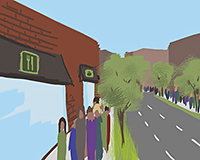 “The main reason these old buildings are so charming is their zero-foot setback from the front property line, which results in a much more pedestrian-friendly streetscape.
Ever since the City created the Chapter 42 development requirements, with 25-ft setbacks along major thoroughfares (of which Washington is one) and minimum parking requirements, retail development shifted from pedestrian-friendly zero building line (e.g. 19th St or Rice Village) to strip centers with two rows of parking in front.
After all, if you can’t build within 25 feet of the building line, you might as well put cars there.” [Angostura, commenting on A Restaurant Renovation in the Old Sixth Ward] Illustration: Lulu
“The main reason these old buildings are so charming is their zero-foot setback from the front property line, which results in a much more pedestrian-friendly streetscape.
Ever since the City created the Chapter 42 development requirements, with 25-ft setbacks along major thoroughfares (of which Washington is one) and minimum parking requirements, retail development shifted from pedestrian-friendly zero building line (e.g. 19th St or Rice Village) to strip centers with two rows of parking in front.
After all, if you can’t build within 25 feet of the building line, you might as well put cars there.” [Angostura, commenting on A Restaurant Renovation in the Old Sixth Ward] Illustration: Lulu
COMMENT OF THE DAY: VISIONS OF A FREEWAY LINED WITH OFFICE BUILDINGS  “I live in the area and I think it’s a big improvement on a used car lot. I would love to see the remaining car dealerships gradually moved away and a continuous strip of mid/high rises from Memorial City to Hwy 6. Now that would be a true ‘Energy Corridor.’†[outwest, commenting on A New 17-Story Office Tower Just Like the Others in the Energy Corridor] Illustration: Lulu
“I live in the area and I think it’s a big improvement on a used car lot. I would love to see the remaining car dealerships gradually moved away and a continuous strip of mid/high rises from Memorial City to Hwy 6. Now that would be a true ‘Energy Corridor.’†[outwest, commenting on A New 17-Story Office Tower Just Like the Others in the Energy Corridor] Illustration: Lulu
COMMENT OF THE DAY RUNNER-UP: HOW AND WHERE HOUSTON’S GONNA FIT ALL THOSE NEWCOMERS 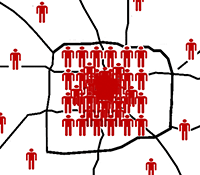 “More density is coming to the Heights and every other Inner Loop neighborhood, because the economic factors at work are unstoppable. Barring a disaster wrecking Houston (natural or otherwise) or an economic crash, more people are coming, and lots of them will want to live near the central parts of the city. All we’re debating is how that will happen. Will needed infrastructure improvements happen? Will there be better transit? Will the density be added in a way to preserves the original neighborhood, and what does that look like?
I have no problem with this kind of development along Yale or Studewood. I think an ideal outcome is main streets with good transit access and dense housing, retail, etc. with historically significant neighborhoods preserved nearby. I think what Arlington County, VA has done along these lines stands as an excellent example.
And the idea that renters bring a neighborhood down is just stupid. unless your idea of a dynamic Heights is one where the average age is 50.” [John (another one), commenting on A Second Midrise Alexan Planned Right Beside the First One on Yale] Illustration: Lulu
“More density is coming to the Heights and every other Inner Loop neighborhood, because the economic factors at work are unstoppable. Barring a disaster wrecking Houston (natural or otherwise) or an economic crash, more people are coming, and lots of them will want to live near the central parts of the city. All we’re debating is how that will happen. Will needed infrastructure improvements happen? Will there be better transit? Will the density be added in a way to preserves the original neighborhood, and what does that look like?
I have no problem with this kind of development along Yale or Studewood. I think an ideal outcome is main streets with good transit access and dense housing, retail, etc. with historically significant neighborhoods preserved nearby. I think what Arlington County, VA has done along these lines stands as an excellent example.
And the idea that renters bring a neighborhood down is just stupid. unless your idea of a dynamic Heights is one where the average age is 50.” [John (another one), commenting on A Second Midrise Alexan Planned Right Beside the First One on Yale] Illustration: Lulu
COMMENT OF THE DAY: HOW DID HOUSTON CHANGE FROM TOWNHOMES TO APARTMENTS? 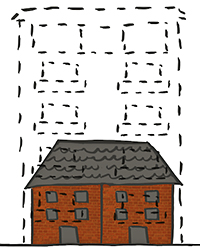 “Before the financial crash in 2008, developers were giddy to get large lots such as these and develop them into townhomes or high-end single family residential. See, for example, the townhomes that sit up against the railroad tracks on Center Street that now have a view of the Wal Mart parking lot. Or the gated community at Washington Ave. and Memorial Heights.
Since then, I’m seeing more of these parcels developed into mid rise apartments, or shopping centers. Did something change in regards to bank financing or is this a response to more out of town money investing in Houston because it’s a ‘hot market’? Does anyone here know the answer?” [ShadyHeightster, commenting on A Second Midrise Alexan Planned Right Beside the First One on Yale] Illustration: Lulu
“Before the financial crash in 2008, developers were giddy to get large lots such as these and develop them into townhomes or high-end single family residential. See, for example, the townhomes that sit up against the railroad tracks on Center Street that now have a view of the Wal Mart parking lot. Or the gated community at Washington Ave. and Memorial Heights.
Since then, I’m seeing more of these parcels developed into mid rise apartments, or shopping centers. Did something change in regards to bank financing or is this a response to more out of town money investing in Houston because it’s a ‘hot market’? Does anyone here know the answer?” [ShadyHeightster, commenting on A Second Midrise Alexan Planned Right Beside the First One on Yale] Illustration: Lulu
COMMENT OF THE DAY: ASHES TO ASHES, DUST TO DUSTING  “Looking at that house on Deal, I think, as I often do with the daily demolitions: that looks so wonderfully easy to keep clean. You’d have a little time to sit and drink iced tea on that side entry porch. Where others see a space to fill — and I realize that’s the better impulse, ultimately, to want to build something, even something as hideous as the house across the street — I just see time. That’s the direction my thoughts take 7665 days of housework later.” [luciaphile, commenting on Daily Demolition Report: Deal and No Deal] Illustration: Lulu
“Looking at that house on Deal, I think, as I often do with the daily demolitions: that looks so wonderfully easy to keep clean. You’d have a little time to sit and drink iced tea on that side entry porch. Where others see a space to fill — and I realize that’s the better impulse, ultimately, to want to build something, even something as hideous as the house across the street — I just see time. That’s the direction my thoughts take 7665 days of housework later.” [luciaphile, commenting on Daily Demolition Report: Deal and No Deal] Illustration: Lulu
COMMENT OF THE DAY RUNNER-UP: HOUSTON HAS ITS COMMUTER RAIL ALREADY, AND IT’S SPELLED H-O-V  “(1) We have one of the best suburb-to-downtown commuter transit systems in the country in the form of the HOV buses, which METRO has invested a lot of money into (the HOV lanes and transit centers cost $1 billion or so to build, and the service is more expensive to operate per rider than either rail or local bus.) 50% of the people who work downtown and live in the areas served by the park & rides already take transit. Commuter rail would be slower, less frequent, and less convenient. The 290 study showed that a $300 million commuter rail line could actually decrease transit ridership. So why should we build commuter rail in corridors that already have park & ride?
(2) Grade separated rail is great, but it’s not cheaper — cost is twice or more of at grade. Subway is 4 times or more. So the question is not if grade separation is good; the question is if grade separation is worth the extra cost. And nobody — not even Chicago — is building elevated rail above city streets, so if you want to grade separate you either need to be lucky enough to have an old rail line or a freeway exactly where people want to go or you need to pay for a subway.” [Christof Spieler, commenting on Comment of the Day: Developing at the Speed of Light Rail] Illustration: Lulu
“(1) We have one of the best suburb-to-downtown commuter transit systems in the country in the form of the HOV buses, which METRO has invested a lot of money into (the HOV lanes and transit centers cost $1 billion or so to build, and the service is more expensive to operate per rider than either rail or local bus.) 50% of the people who work downtown and live in the areas served by the park & rides already take transit. Commuter rail would be slower, less frequent, and less convenient. The 290 study showed that a $300 million commuter rail line could actually decrease transit ridership. So why should we build commuter rail in corridors that already have park & ride?
(2) Grade separated rail is great, but it’s not cheaper — cost is twice or more of at grade. Subway is 4 times or more. So the question is not if grade separation is good; the question is if grade separation is worth the extra cost. And nobody — not even Chicago — is building elevated rail above city streets, so if you want to grade separate you either need to be lucky enough to have an old rail line or a freeway exactly where people want to go or you need to pay for a subway.” [Christof Spieler, commenting on Comment of the Day: Developing at the Speed of Light Rail] Illustration: Lulu
COMMENT OF THE DAY SECOND RUNNER-UP: NO ZONING MEANS WE’LL ALWAYS HAVE TRAFFIC SURPRISES “If there was only a way to plan for traffic and infrastructure by knowing the density that a site will have in the future . . . Oh yeah, its called Zoning. Then you know the worst case development scenario. And if you ever want to build bigger than you have to upgrade the infrastructure first. Nah, why do that, we can just let people build as big as they want and try and fix the problems later. Unless you are for zoning and rules than you can’t complain about traffic. They are the same. [DD, commenting on A Second Midrise Alexan Planned Right Beside the First One on Yale]
COMMENT OF THE DAY: THE BIGGEST BACKUP ON THE WAY TO WORK 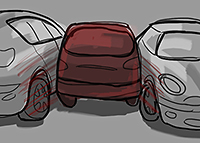 “The worst part of the commute is the parking garage. I live in the Loop and have a roughly 20 minute commute — I timed it at 21 yesterday morning at 8:45 and I got home in 16 around 6 but it often takes me 10 minutes or more to navigate the parking garage and its the most agonizing 10 minutes of the day. On days I don’t drive it’s not the lack of traffic that makes me smile, it’s not having to honk at someone who is about to hit me in reverse because they can’t figure out that no matter how hard they try their Denali is not going to fit into that compact spot.” [cellardwellar, commenting on Comment of the Day: Enjoying the Fruits of Commuting] Illustration: Lulu
“The worst part of the commute is the parking garage. I live in the Loop and have a roughly 20 minute commute — I timed it at 21 yesterday morning at 8:45 and I got home in 16 around 6 but it often takes me 10 minutes or more to navigate the parking garage and its the most agonizing 10 minutes of the day. On days I don’t drive it’s not the lack of traffic that makes me smile, it’s not having to honk at someone who is about to hit me in reverse because they can’t figure out that no matter how hard they try their Denali is not going to fit into that compact spot.” [cellardwellar, commenting on Comment of the Day: Enjoying the Fruits of Commuting] Illustration: Lulu
COMMENT OF THE DAY: DEVELOPING AT THE SPEED OF LIGHT RAIL 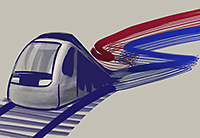 “Light rail has not to date really spurred development around it’s stations because it is not a speedier transit option for people along it’s route. I’m pretty sure you can drive from Main and Bell to Binz just as fast as it would take on LRT, because the trains ride in the street and also stop for cross traffic in some spots. Also, traffic congestion along Main St., or the East End is nowhere near a critical mass that driving becomes something you want to avoid.
Dallas’ DART rail used railway right of ways that took the trains off the street grid, and is able to provide speedy transit down the North Central Expressway corridor. Real estate development followed around the station nodes because people are willing to eat/shop/live close to a station that lets them avoid a terribly congested highway at rush hour.
METRO did own old railroad ROW’s along Westpark and the Katy Freeway, but never had anyone in charge that was willing to develop those ROW’s for rail use. They became concrete highways instead.” [ShadyHeightster, commenting on Where Downtown Has Developed, Is Developing, and Might Develop Some More] Illustration: Lulu
“Light rail has not to date really spurred development around it’s stations because it is not a speedier transit option for people along it’s route. I’m pretty sure you can drive from Main and Bell to Binz just as fast as it would take on LRT, because the trains ride in the street and also stop for cross traffic in some spots. Also, traffic congestion along Main St., or the East End is nowhere near a critical mass that driving becomes something you want to avoid.
Dallas’ DART rail used railway right of ways that took the trains off the street grid, and is able to provide speedy transit down the North Central Expressway corridor. Real estate development followed around the station nodes because people are willing to eat/shop/live close to a station that lets them avoid a terribly congested highway at rush hour.
METRO did own old railroad ROW’s along Westpark and the Katy Freeway, but never had anyone in charge that was willing to develop those ROW’s for rail use. They became concrete highways instead.” [ShadyHeightster, commenting on Where Downtown Has Developed, Is Developing, and Might Develop Some More] Illustration: Lulu
COMMENT OF THE DAY: ENJOYING THE FRUITS OF COMMUTING  “I spend a lot of time and money commuting from Pearland. I have done so since 1990, so I’ve seen the average time double since I moved out there. It could be true that over 30 years or so I’ll spend as much or more money on gasoline and travel costs as I would have spent on a closer-in place. But you know what? I got a screaming deal on a house I really like. My house payments are way lower than in-town rent and I would never be able to qualify for an in-town mortgage. I have a car I love and I’m a maintenance freak who does a lot of my own mechanical work myself. I haven’t had a car payment in nine years. Anse’s 45 minutes each way? That’s me. That’s an hour and a half of very rewarding music listening, podcasts, audiobooks, you name it, enforced each day. And all that cultural stuff that is ‘easier’ close in? You know, restaurants, bars, movies, plays, concerts, festivals, etc.? It’s all doubled or more than doubled in price since the ’90s. In the very, very long term, like a normal lifespan, it might be cheaper to live closer. But on a day-to-day basis, for a lot of us, it’s simply not affordable, and if it were borderline affordable, it wouldn’t be worth it.” [marmer, commenting on Comment of the Day: The Lies Houston Drivers Tell Themselves] Illustration: Lulu
“I spend a lot of time and money commuting from Pearland. I have done so since 1990, so I’ve seen the average time double since I moved out there. It could be true that over 30 years or so I’ll spend as much or more money on gasoline and travel costs as I would have spent on a closer-in place. But you know what? I got a screaming deal on a house I really like. My house payments are way lower than in-town rent and I would never be able to qualify for an in-town mortgage. I have a car I love and I’m a maintenance freak who does a lot of my own mechanical work myself. I haven’t had a car payment in nine years. Anse’s 45 minutes each way? That’s me. That’s an hour and a half of very rewarding music listening, podcasts, audiobooks, you name it, enforced each day. And all that cultural stuff that is ‘easier’ close in? You know, restaurants, bars, movies, plays, concerts, festivals, etc.? It’s all doubled or more than doubled in price since the ’90s. In the very, very long term, like a normal lifespan, it might be cheaper to live closer. But on a day-to-day basis, for a lot of us, it’s simply not affordable, and if it were borderline affordable, it wouldn’t be worth it.” [marmer, commenting on Comment of the Day: The Lies Houston Drivers Tell Themselves] Illustration: Lulu
COMMENT OF THE DAY: THE LIES HOUSTON DRIVERS TELL THEMSELVES  “I’m convinced that everyone in Houston lies to themselves (and others) regarding their commute. Ask someone who works downtown and lives in Sugarland or the Woodlands what their commute is. ‘30 to 45 minutes, it’s not that bad’ will be their response. What a lie! It takes 10-20 minutes just to get from a downtown garage to a freeway most days. Perhaps they are only spending 30-45 minutes on the freeway (on a good day), but they are forgetting the 15 it took on get on the freeway and the 15-20 it takes to get from the freeway to their driveway. But its not just people from the burbs that lie about their commute. Talk to someone who lives in Montrose or the Heights and they’ll brag that their commute to downtown is only 10 minutes. Total crap! There are intersections that take longer than that to get through. People who live in Midtown might have a 10 minute commute, but that’s on a good day. So here’s the formula I use when calculating someone’s average commute. If they live inside the loop, double whatever commute time they give you. If they live outside the loop, multiply by 2.5. Try it out when talking to coworkers some time, you’ll find that its fairly accurate.” [Walt, commenting on Comment of the Day: How To Drum Up Support for Better Public Transportation in Houston, and Faster] Illustration: Lulu
“I’m convinced that everyone in Houston lies to themselves (and others) regarding their commute. Ask someone who works downtown and lives in Sugarland or the Woodlands what their commute is. ‘30 to 45 minutes, it’s not that bad’ will be their response. What a lie! It takes 10-20 minutes just to get from a downtown garage to a freeway most days. Perhaps they are only spending 30-45 minutes on the freeway (on a good day), but they are forgetting the 15 it took on get on the freeway and the 15-20 it takes to get from the freeway to their driveway. But its not just people from the burbs that lie about their commute. Talk to someone who lives in Montrose or the Heights and they’ll brag that their commute to downtown is only 10 minutes. Total crap! There are intersections that take longer than that to get through. People who live in Midtown might have a 10 minute commute, but that’s on a good day. So here’s the formula I use when calculating someone’s average commute. If they live inside the loop, double whatever commute time they give you. If they live outside the loop, multiply by 2.5. Try it out when talking to coworkers some time, you’ll find that its fairly accurate.” [Walt, commenting on Comment of the Day: How To Drum Up Support for Better Public Transportation in Houston, and Faster] Illustration: Lulu
COMMENT OF THE DAY: HOW TO DRUM UP SUPPORT FOR BETTER PUBLIC TRANSPORTATION IN HOUSTON, FASTER  “Here’s what I say: make drivers suffer. Yeah, I’m going there. Make it worse to drive. Make the traffic back up. Don’t expand any highways for another 20 years. Don’t do it. Force public transit on this town.
Go ahead, blast me, let me have it. I don’t care. I just spent four fabulous days in Chicago, and I’m so sick to death of all the excuses for why public transit won’t work in this town. We want so badly to be seen as a world-class city, but we’re never going to get there this way. Public transportation can and will work but it’s not going to work if we keep pandering to the drivers who caterwaul constantly about the liberty driving allows us while sitting in the parking lot that is the NW Freeway at rush hour. Oh, but they’re going to get their transportation dollars to drop millions on an expansion of the aforementioned parking lot which will need expansion again in 10 years. What a bunch of garbage.
It’s the old chicken-or-the-egg question. Will it be demand that drives public transit or will it be the reverse? Right now, nobody is giving me much in the way of choices, but I suppose they will say because I drive to work every day, I must naturally love it. If I didn’t, I’d go ahead and pad an hour to my commute by taking the bus. They call this a ‘choice.’
It’s a false choice. Suck it up. Building the kind of public transit that is common elsewhere is never cheap, it’s never convenient, it always comes with a price, but so does catering to drivers. I say, to hell with drivers.
I understand there is some contradiction underlying this argument. The best public transit system would require hard choices in this town. A lot of nice, historic real estate would probably have to come down to make way for more stations and more tracks. And that kind of system emphasizes the kind of urban density we say we want but often oppose in specific cases. I’m guilty of that contradiction myself sometimes, I’ll admit it.
But Houston needs to grow up. Force it on us, go ahead. Make life miserable for the suburban commuters we pander to every time this subject comes up. It’s time. The pennypinchers and the naysayers can shove it.” [Anse, commenting on Federal Money Rolls In for Uptown’s Post Oak BRT] Illustration: Lulu
“Here’s what I say: make drivers suffer. Yeah, I’m going there. Make it worse to drive. Make the traffic back up. Don’t expand any highways for another 20 years. Don’t do it. Force public transit on this town.
Go ahead, blast me, let me have it. I don’t care. I just spent four fabulous days in Chicago, and I’m so sick to death of all the excuses for why public transit won’t work in this town. We want so badly to be seen as a world-class city, but we’re never going to get there this way. Public transportation can and will work but it’s not going to work if we keep pandering to the drivers who caterwaul constantly about the liberty driving allows us while sitting in the parking lot that is the NW Freeway at rush hour. Oh, but they’re going to get their transportation dollars to drop millions on an expansion of the aforementioned parking lot which will need expansion again in 10 years. What a bunch of garbage.
It’s the old chicken-or-the-egg question. Will it be demand that drives public transit or will it be the reverse? Right now, nobody is giving me much in the way of choices, but I suppose they will say because I drive to work every day, I must naturally love it. If I didn’t, I’d go ahead and pad an hour to my commute by taking the bus. They call this a ‘choice.’
It’s a false choice. Suck it up. Building the kind of public transit that is common elsewhere is never cheap, it’s never convenient, it always comes with a price, but so does catering to drivers. I say, to hell with drivers.
I understand there is some contradiction underlying this argument. The best public transit system would require hard choices in this town. A lot of nice, historic real estate would probably have to come down to make way for more stations and more tracks. And that kind of system emphasizes the kind of urban density we say we want but often oppose in specific cases. I’m guilty of that contradiction myself sometimes, I’ll admit it.
But Houston needs to grow up. Force it on us, go ahead. Make life miserable for the suburban commuters we pander to every time this subject comes up. It’s time. The pennypinchers and the naysayers can shove it.” [Anse, commenting on Federal Money Rolls In for Uptown’s Post Oak BRT] Illustration: Lulu
COMMENT OF THE DAY: ODE TO THE FAMILY GAS STATION, RECENTLY DEPARTED 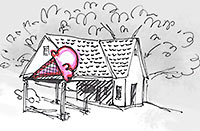 “Yes, it was a sad day. I’ll have a hard time driving down 14th street from now on. I shed a few tears seeing it knocked down. To the [commenter] who suggested it be moved to the park –– it was offered but no takers.
Grandpa’s dad owned the property and grandpa Fred Schauer began running the station when he was a kid (before he was 16 I think). I remember when he got his 50 years Gulf pin. He ran the station from 6 a.m. to 6 p.m. six days a week. But then Gulf stopped delivering to independents who couldn’t support giant tankers and giant loads of gas. That was the beginning of the end. My uncle ran it with some generic gas for a few years after that but the gas market had irrevocably changed.
That station has been closed for many years now and despite the quaint ideas how it might be used (I’ve had a few myself), the business realities today are different. (Just ask the MAM’s ladies what renovations are required for a permanent location for a snowcone shop and you’ll soon understand.)
Both Fred and Hazel have been gone for many years now and the property passed on. This isn’t about greedy real estate developers just realities. Property values soar, taxes soar, maintenance soars, and land use changes. People don’t buy an expensive piece of land to live in a 1100 sf house. The two small adjoining houses will be demolished as well and I’m sure I’ll morbidly drive over to see.
I’m sure the new owners will build a lovely home, and I sincerely hope they’re happy there.” [twyla davis, commenting on The End for the Historic Heights Schauer Filling Station?] Illustration: Lulu
“Yes, it was a sad day. I’ll have a hard time driving down 14th street from now on. I shed a few tears seeing it knocked down. To the [commenter] who suggested it be moved to the park –– it was offered but no takers.
Grandpa’s dad owned the property and grandpa Fred Schauer began running the station when he was a kid (before he was 16 I think). I remember when he got his 50 years Gulf pin. He ran the station from 6 a.m. to 6 p.m. six days a week. But then Gulf stopped delivering to independents who couldn’t support giant tankers and giant loads of gas. That was the beginning of the end. My uncle ran it with some generic gas for a few years after that but the gas market had irrevocably changed.
That station has been closed for many years now and despite the quaint ideas how it might be used (I’ve had a few myself), the business realities today are different. (Just ask the MAM’s ladies what renovations are required for a permanent location for a snowcone shop and you’ll soon understand.)
Both Fred and Hazel have been gone for many years now and the property passed on. This isn’t about greedy real estate developers just realities. Property values soar, taxes soar, maintenance soars, and land use changes. People don’t buy an expensive piece of land to live in a 1100 sf house. The two small adjoining houses will be demolished as well and I’m sure I’ll morbidly drive over to see.
I’m sure the new owners will build a lovely home, and I sincerely hope they’re happy there.” [twyla davis, commenting on The End for the Historic Heights Schauer Filling Station?] Illustration: Lulu
COMMENT OF THE DAY: THOSE MCMANSIONS ARE GIVING TIMBERGROVE A NEEDED LIFT “Those pics for the Shirkmere listing show some example samples of McMansions in Timbergrove and the floors appear to all be raised 3-4 feet above grade. I like those simple 50s homes but, considering the flood potential, the raised McMansions are an upgrade of the neighborhood in more ways than 1.” [Dana-X, commenting on Daily Demolition Report: Trulley, Madly, Deeply]

